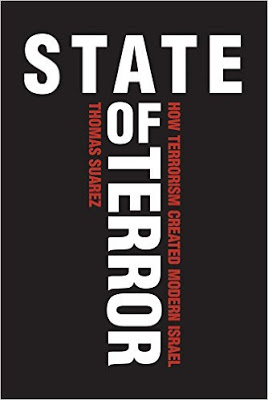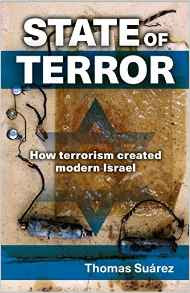Zionism ‘Started with the kind of
aims with which Hitler started’ Robert Waley Cohen
aims with which Hitler started’ Robert Waley Cohen
The first thorough analysis of
relevant British and US archives, 16 Dec. 2016
relevant British and US archives, 16 Dec. 2016
State of Terror: How terrorism created modern Israel.
Thomas Suárez. Bloxham, UK: Skyscraper Publications.
Thomas Suárez. Bloxham, UK: Skyscraper Publications.
This review is from: State of
Terror (Hardcover)
Terror (Hardcover)
I haven’t read this book but it
seems fascinating. I and others have
always known about how the Zionist movement sought to block any avenues of
escape, other than Palestine, for Jewish refugees during WW2 . The aim was to use the refugees in order to batter open the gates of Palestine for Jewish immigration.
seems fascinating. I and others have
always known about how the Zionist movement sought to block any avenues of
escape, other than Palestine, for Jewish refugees during WW2 . The aim was to use the refugees in order to batter open the gates of Palestine for Jewish immigration.
We also know, not least from the
agents involved,such as Naim Giladi, that Zionist agents were involved in
planting bombs in areas Jews frequented in Iraq and Morocco, among other Arab
states, with the aim of simulating anti-Semitism and thereby provoking a
stampede of Jews to the Israeli state.
agents involved,such as Naim Giladi, that Zionist agents were involved in
planting bombs in areas Jews frequented in Iraq and Morocco, among other Arab
states, with the aim of simulating anti-Semitism and thereby provoking a
stampede of Jews to the Israeli state.
However I didn’t know about the targeting
of non-Zionist Jews although nothing about Zionism would at all surprise me.
of non-Zionist Jews although nothing about Zionism would at all surprise me.
Today, as Zionism seeks to
portray itself as the ‘national liberation movement of Jews’ the kind of movement
in whose mouth butter wouldn’t melt, it’s good to be reminded of the sordid
racist and bloody record of the Zionist movement.
portray itself as the ‘national liberation movement of Jews’ the kind of movement
in whose mouth butter wouldn’t melt, it’s good to be reminded of the sordid
racist and bloody record of the Zionist movement.
Tony Greenstein
People interested in knowing how
the state of Israel came to be established are indebted to Israeli historians,
in particular Tom Segev, Benny Morris, Avi Shlaim and Ilan Pappé. Drawing on
archives and other Israeli sources, these researchers have provided us with
evidence that standard Zionist narratives about the creation of Israel do not
stand up to scrutiny.
the state of Israel came to be established are indebted to Israeli historians,
in particular Tom Segev, Benny Morris, Avi Shlaim and Ilan Pappé. Drawing on
archives and other Israeli sources, these researchers have provided us with
evidence that standard Zionist narratives about the creation of Israel do not
stand up to scrutiny.
It seems surprising that, until
now, relevant British Government archives have not received detailed attention.
Thomas Suárez has now published a 400-page account of his findings from
meticulous research, drawing especially on documents in the British National
Archives at Kew, London, and also US Central Intelligence Agency papers. Ilan
Pappé describes Suárez’s book – State of Terror – as “the first comprehensive
and structured analysis of the violence and terror employed by the Zionist
movement and later the state of Israel against the people of Palestine.”
now, relevant British Government archives have not received detailed attention.
Thomas Suárez has now published a 400-page account of his findings from
meticulous research, drawing especially on documents in the British National
Archives at Kew, London, and also US Central Intelligence Agency papers. Ilan
Pappé describes Suárez’s book – State of Terror – as “the first comprehensive
and structured analysis of the violence and terror employed by the Zionist
movement and later the state of Israel against the people of Palestine.”
What does State of Terror tell us
that we didn’t already know about the violence and terror, within Palestine and
beyond, employed by a determined settler-colonialist movement led principally
by European, secular Jews?
that we didn’t already know about the violence and terror, within Palestine and
beyond, employed by a determined settler-colonialist movement led principally
by European, secular Jews?
The book refers to widely known
terrorist acts against the British mandate government of Palestine (such as the
dynamiting of the King David Hotel), and to terrorist attacks on the indigenous
population of Palestine (such as that at Deir Yassin). State of Terror
‘revisits’ these notorious examples of terror directed against targets that
stood in the way of establishing an ethno-supremacist settler state intended
exclusively for Jews, and self-defined as the state of all Jews, everywhere.
terrorist acts against the British mandate government of Palestine (such as the
dynamiting of the King David Hotel), and to terrorist attacks on the indigenous
population of Palestine (such as that at Deir Yassin). State of Terror
‘revisits’ these notorious examples of terror directed against targets that
stood in the way of establishing an ethno-supremacist settler state intended
exclusively for Jews, and self-defined as the state of all Jews, everywhere.
Suárez introduced me to many
other examples of Zionist terrorism with which I was not familiar, documented
in almost numbing detail, and supported by references to hundreds of archival
documents. Anyone who wishes to challenge his analysis has a great deal of work
to do.
other examples of Zionist terrorism with which I was not familiar, documented
in almost numbing detail, and supported by references to hundreds of archival
documents. Anyone who wishes to challenge his analysis has a great deal of work
to do.
A feature of the book which has
not been covered systematically elsewhere is terrorism and other measures used
by the Zionist movement against non-Zionist Jews, within and outside Palestine.
Some of these have also previously been well documented, but are less well
known than they should be. They reveal the lengths to which the Zionist
movement was prepared to go to secure its ambitions to populate Palestine and
neighbouring territories with Jews, and ‘cleanse’ these territories of
non-Jews.
not been covered systematically elsewhere is terrorism and other measures used
by the Zionist movement against non-Zionist Jews, within and outside Palestine.
Some of these have also previously been well documented, but are less well
known than they should be. They reveal the lengths to which the Zionist
movement was prepared to go to secure its ambitions to populate Palestine and
neighbouring territories with Jews, and ‘cleanse’ these territories of
non-Jews.
Zionism –
“starting with the kind of aims with which Hitler had started…. seemed to be
based on one religion and one race.”, Robert Waley Cohen
“starting with the kind of aims with which Hitler had started…. seemed to be
based on one religion and one race.”, Robert Waley Cohen
In
November 1940, under the authority of future prime minister Moshe Sharett, a
Hagana bomber blew a hole in the side of the ship Patria to prevent its departure
for Displaced Persons to camps in Mauritius. Of the 267 killed, most were Jews
fleeing the war in Europe. Cinemas, printing presses, kiosks, radar stations,
bridges, trains, roads, and cars were bombed, and the terror did not just
target British and Palestinians, but ‘uncooperative’ Jews as well.
November 1940, under the authority of future prime minister Moshe Sharett, a
Hagana bomber blew a hole in the side of the ship Patria to prevent its departure
for Displaced Persons to camps in Mauritius. Of the 267 killed, most were Jews
fleeing the war in Europe. Cinemas, printing presses, kiosks, radar stations,
bridges, trains, roads, and cars were bombed, and the terror did not just
target British and Palestinians, but ‘uncooperative’ Jews as well.
Suárez
writes: “Both before and after 1948, hundreds of thousands of people in Europe,
North Africa, and the Middle East became fair game for Zionist violence because
they were Jewish, since Zionism depended not just on the transfer of non-Jewish
Palestinians out of Palestine, but also on the transfer of Jews into Palestine.
Anti-Jewish tactics included manipulating the Displaced Persons (DC) camps,
thwarting safe haven opportunities in other countries [than Palestine],
kidnapping Jewish orphans, [persuading Jewish children of non-Zionist Jews to
betray their parents], and, [after 1948], destroying Jewish communities in
North Africa and the Middle East through propaganda and false-flag ‘Arab’
terrorism – all to ship ‘ethnically correct’ people to Palestine in the service
of the settler state”.
writes: “Both before and after 1948, hundreds of thousands of people in Europe,
North Africa, and the Middle East became fair game for Zionist violence because
they were Jewish, since Zionism depended not just on the transfer of non-Jewish
Palestinians out of Palestine, but also on the transfer of Jews into Palestine.
Anti-Jewish tactics included manipulating the Displaced Persons (DC) camps,
thwarting safe haven opportunities in other countries [than Palestine],
kidnapping Jewish orphans, [persuading Jewish children of non-Zionist Jews to
betray their parents], and, [after 1948], destroying Jewish communities in
North Africa and the Middle East through propaganda and false-flag ‘Arab’
terrorism – all to ship ‘ethnically correct’ people to Palestine in the service
of the settler state”.
At a
secret meeting in London in 1941 which involved Weizmann and Ben Gurion, a
non-Zionist industrialist, Robert Waley Cohen, observed that the Zionists were
“starting with the kind of aims with which Hitler had started”, and which
“seemed to be based on one religion and one race.” When, a few years later,
Roosevelt developed a plan to resettle half a million persons displaced by
fascism in Europe, the initiative was derailed by Zionists intent on denying
resettlement of European Jews anywhere other than Palestine.
secret meeting in London in 1941 which involved Weizmann and Ben Gurion, a
non-Zionist industrialist, Robert Waley Cohen, observed that the Zionists were
“starting with the kind of aims with which Hitler had started”, and which
“seemed to be based on one religion and one race.” When, a few years later,
Roosevelt developed a plan to resettle half a million persons displaced by
fascism in Europe, the initiative was derailed by Zionists intent on denying
resettlement of European Jews anywhere other than Palestine.
More than
any other book I have read, Thomas Suárez’s State of Terror lays bare the
ruthlessness of the Zionist movement in its determination – unbroken since its
inception at the end of the 19th century and continuing today – to establish a
settler state with no defined borders, populated exclusively by Jews. And the
book really brought home to me the ways that Zionism has benefitted from (and
continues to thrive on) discrimination against Jews – real, alleged, or
actively manufactured.
any other book I have read, Thomas Suárez’s State of Terror lays bare the
ruthlessness of the Zionist movement in its determination – unbroken since its
inception at the end of the 19th century and continuing today – to establish a
settler state with no defined borders, populated exclusively by Jews. And the
book really brought home to me the ways that Zionism has benefitted from (and
continues to thrive on) discrimination against Jews – real, alleged, or
actively manufactured.
Politicians
and others who acquiesce in or actively support the methods used by Zionism
should read this book and consider what lessons it holds, not only for the
people of Israel and Palestine as Zionism acts out ethno-religious superiority
and messianic fundamentalism, but for all of us, given that Israel is one of
the world’s few nuclear-armed states.
and others who acquiesce in or actively support the methods used by Zionism
should read this book and consider what lessons it holds, not only for the
people of Israel and Palestine as Zionism acts out ethno-religious superiority
and messianic fundamentalism, but for all of us, given that Israel is one of
the world’s few nuclear-armed states.
Iain
Chalmers
Chalmers
16
December 2016
December 2016
Declaration:
I learned of Britain’s key role in creating the Israeli-Palestinian conflict
during my first visit to Palestine in 1963. I subsequently worked for two years
as a United Nations medical officer in Khan Younis in a clinic then serving
over 40,000 refugees. I have returned to Gaza at intervals since then. I am a
member of the steering group of the Lancet-Palestinian Health Alliance to
promote research to help improve health and health services for Palestinians. I
make financial donations to several Israeli and Palestinian human rights
organisations and charities.
I learned of Britain’s key role in creating the Israeli-Palestinian conflict
during my first visit to Palestine in 1963. I subsequently worked for two years
as a United Nations medical officer in Khan Younis in a clinic then serving
over 40,000 refugees. I have returned to Gaza at intervals since then. I am a
member of the steering group of the Lancet-Palestinian Health Alliance to
promote research to help improve health and health services for Palestinians. I
make financial donations to several Israeli and Palestinian human rights
organisations and charities.
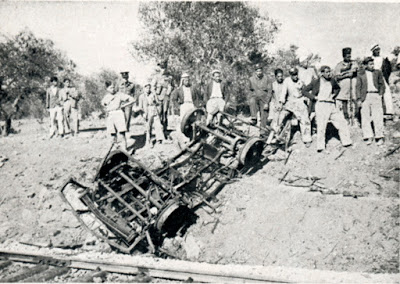 |
| 1946 train bombing, image from Tom Suarez’s book State of Terror |
A review of State of Terror: How terrorism created modern Israel, by Thomas Suárez. Published today in the UK, available for pre-order in the U.S.
To introduce the theme of this book, I can do no better than to quote its endorsement by Prof. Ilan Pappé:
A tour de force, based on diligent archival research that looks boldly at the impact of Zionism on Palestine and its people in the first part of the 20th century. The book is the first comprehensive and structured analysis of the violence and terror employed by the Zionist movement, and later the state of Israel, against the people of Palestine.
Thanks to Prof. Pappé and other Israeli ‘new’ historians working from Israeli government archives, we now have a good understanding of the extent of the catastrophe which befell the Palestinian people in the 1947-49 period as the Zionist forces fought through Palestine either driving out the non-Jewish population, or, if they fled, taking over their property and destroying empty villages.
The less well-known history of the period before this, from the Balfour Declaration of 1917 through the British Mandate of 1922-1948 has now been thoroughly researched in this new book by Thomas Suárez, working largely from British Government archives. He continues the story until the end of the 1956 war in which Israel, Britain and France attacked Egypt.
The book is a substantial work of historical scholarship of over 400 pages, including 680 endnotes, some of them long paragraphs quoting several sources. There is also a very comprehensive index, and a few contemporary photographs. Some maps of the territory would have helped the reader follow the story.
The story he tells is of a Zionist elite determined from the beginning to turn all of Palestine into a Jewish state in which the local non-Jewish Arab population would be either subjugated or expelled. The Zionists were quite willing to use violence and terrorism to achieve this aim, and the book traces the resulting unhappy history in detail, to the extent that, in places, it reads like a catalog of Zionist terror attacks. The Zionist policy is made clear in this quote from Menachem Begin, later a Prime Minister of Israel, which appears at the head of the book’s Introduction:
“We intend to attack, conquer and keep until we have the whole of Palestine and Transjordan in a Greater Jewish State”.
The author does not deny or condone the existence of Palestinian Arab terrorism, but shows how it was then (and remains today) “a reaction to Zionist ethnic subjugation and expropriation of land, resources and labour, with non-violent resistance having proved futile”. Whereas the Palestinian terrorists were loose bands of guerillas operating in the country districts, the Zionist terrorists were organized militias operating from within urban centers under the protection of those communities.
As Palestinian terrorism died down after the brutal suppression of the Arab protests in 1936, Zionist terror escalated, particularly after the 1939 White Paper which placed restrictions on Jewish immigration, “targeting anyone in the way of its political objectives – Palestinian, British or Jewish”. During the second world war, the official Zionist militia, Hagana, toned down its attacks on the British. Both Arab and Jewish Palestinians volunteered to join the Allied forces, though the Jews insisted on their own regiment.
From 1942 onwards, when it was clear that the Allies were going to win the war, the Zionists restarted their campaign of wholesale terrorism (as the British described it) to establish a Zionist state by force: a campaign which eventually forced Britain’s decision to abandon the Mandate, leading to the UN Partition Plan, civil war, ethnic-cleansing of the Arab population, and the unilateral declaration of the State of Israel in 1948.
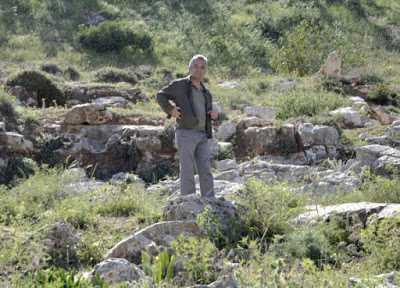 |
| Tom Suárez in the West Bank. Photo credit Sainatee Suárez |
The book makes the important point that in the early days most of world Jewry were opposed to Zionism. In Britain, the Jewish cabinet minister Lord Montagu, supported by other Jewish leaders, viewed the Zionists as collaborators with the anti-semites who were delighted with the idea of the Jews expelling themselves from their current homelands. Montagu was instrumental in changing the aim of the Balfour Declaration from “Palestine AS THE Jewish national home” to the vaguer “A Jewish national home IN Palestine”. Orthodox Jews, including the indigenous Arab Jews of Palestine, thought that the return of the Jews to the Land of Israel could not take place until the time of the Messiah, and rejected Zionism as an attempt to replace Jewish religion with a secular, nationalistic ideology. Liberal Jews did not believe that Jews constituted a national group who needed a political home, and were loyal to their existing homeland. In the USA a group of (mainly Reform) rabbis established the anti-Zionist American Council for Judaism, still active today.
The book also reveals the Zionist willingness to use violence against their Jewish opponents; their conviction that all Jews had an obligation to leave their homelands to go to Palestine; their willingness to stir up anti-semitism to encourage such migration; and their attempts to prevent displaced Jews going anywhere other than Palestine.
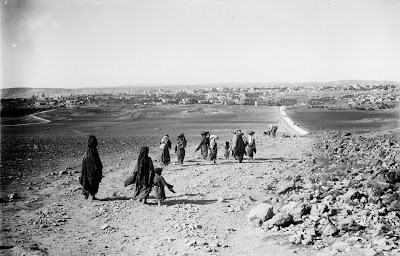 |
| Jerusalem from the north, during the Mandate period, an image from Tom Suarez’s book State of Terror |
The coverage of historical events in the book is somewhat sketchy, and might confuse the general reader not already familiar with the topic: for example, the 1917 Balfour Declaration is discussed but the text is not provided. It presents the 1947 UN Partition Plan simply as a division of Palestine (excluding Jerusalem) into two states, Jewish and Arab, as if they were to be independent sovereign states. In fact, they were to be joined in a confederation effectively under UN trusteeship, and created by a process in which there was no place for a unilateral declaration of independence. Ben-Gurion’s attempt in Israel’s Declaration of Establishment to justify it through the Partition Plan was a fraud. We are told that the Declaration did not acknowledge any borders for the new state, but not told that the Zionists were forced to make a formal declaration of borders as proposed by the Partition Plan in order to achieve recognition by the USA. This is significant because it makes it clear that Israel was not invaded by 5 Arab armies on 15 May 1948, as Zionists claim: most of the fighting in the subsequent war was outside its borders, and only Syrian and Egyptian troops entered Israeli territory.
This book is true, and it is important. It proves beyond doubt that Israel is not the perpetual victim of Arab violence that it claims to be, but has been the aggressor throughout the history of the conflict.
Thomas Suárez is to be congratulated and thanked for his work. This book is a tremendous achievement by a writer who is also a talented musician and an expert in historic cartography.
Publication Information
UK Edition published by Skyscraper Publications, 13 October 2016, RRP £20.
Format: Hardcover, 417 pages
ISBN: 978-1911072034
Available on amazon.co.uk
US Edition published by Interlink-Olive Branch, November 23, 2016, $20
Format: Paperback, 288 pages
ISBN: 978-1566560689
Available for pre-order on amazon.com.
Electronic edition forthcoming. The book has its own website at state-of-terror.net
Posted in Blog
